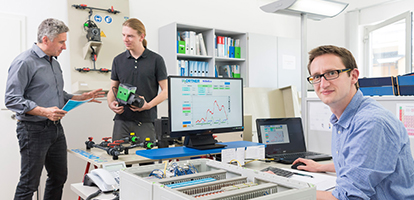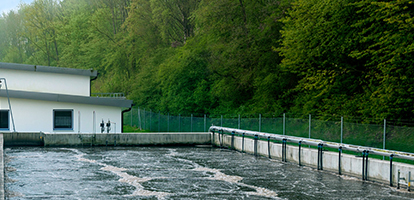


Using WAGO technology, H2Ortner® GmbH from Passau developed a controller module that gives operators of wastewater treatment plants needbased control of the blowers in their aeration tanks depending on the degree of contamination in the wastewater. This type of control saves electricity, lowers the nitrogen concentration in the discharge and increases operational reliability. Practical experience shows that in many cases, plant operators can recoup the investment through the waiver of the wastewater discharge fees alone.
In any modern wastewater treatment plant, there are team members who work around the clock without vacation time or even payment: these are the bacteria that break down harmful substances in the wastewater in the aeration basin. All that the microorganisms need for their work is oxygen, and in return, they carry out nitrification – the conversion of nitrogenous ammonia into nitrate. The oxygen is injected into the aeration tanks via blowers. In the case of small and medium-sized wastewater treatment plants, these are usually controlled by a timer – regardless of the actual contamination level in the wastewater influent. This approach also ignores the dynamics of the biological processes in the aeration tank. The operation is usually implemented under that assumption that “more is better.” In this case, it is better to aerate a little longer in order to ensure that the required limiting values are actually met. However, since the blowers require a great deal of power, this approach drives up the energy costs. Furthermore, an excess of oxygen impedes the stage following nitrification – denitrification – in which the nitrates that were generated are then reduced to molecular nitrogen. This means that the discharge values are not as low as they could be. As a result, plant operators often have to pay unnecessarily high wastewater discharge fees.
These are some of the reasons why H2Ortner, wastewater purification experts from Passau, developed a solution for need-based blower control. The system, which they named “NiDeEco” and equipped with WAGO automation technology, ensures that the aerobic bacteria have an optimal oxygen supply in the aeration tank at all times. “Our controller module allows the operators of wastewater treatment plants to lower the nitrogen concentration in their discharge and simultaneously reduce their energy costs,” explains CEO Josef Ortner. Furthermore, the system makes it possible to optimize the elimination of phosphorus.
Process Dynamics at a Glance
NiDeEco regulates the blowers, and thus controls nitrification and denitrification, as a function of the level of contamination in the wastewater. The current oxygen, ammonia and nitrate values, which are recorded by sensors – either existing or newly installed ones – are the starting point. The data is wirelessly transferred to the controller module, where a software application determines the treatment performance from the sensor data, and then calculates the optimal oxygenation level on this basis. However, the system does not use the individual values; the process is based on curve progressions instead. “This allows us to take the dynamics of the processes into account – a great advantage for precise, accurate control of the blowers,” explains Ortner. In the process, NiDeEco is able to directly control blowers, and also address higher-level controllers.
The core of the controller module is the WAGO PFC200 Controller. The parameterization and monitoring of the processes is web-based. Employees can access the controller using a standard PC, tablet or smartphone via a secure IP address. That provides flexibility, since they can keep an eye on all values from afar, such as from home. A clearly organized interface allows for fast comprehension of all relevant data. Furthermore, this allows the employees to set all parameters themselves with minimal effort. “Instead of a black box, it was important for us to create a solution that offers our customers independence from individual manufacturers,” says Ortner.
The WAGO controller provides additional important advantages. “These include the option to carry out parameterization and visualization directly in the controller module via the IP address, for example. Furthermore, with its many interfaces, the product offers ideal options for communication with different controllers. And don’t forget WAGO’s excellent price-performance ratio, which really stands out,” explains Ortner.
Recouping Investments through the Waiver of the Wastewater Discharge Fees NiDeEco is already in use in twenty wastewater treatment plants around Germany, mostly small and medium-sized plants. In each case, power consumption has been successfully reduced by at least twenty percent. This significantly relieves the burden on the operators, which can be illustrated using a population equivalent, which describes the capacity of a wastewater treatment plant.
For instance, for a plant designed for a population of 10,000, a 20% reduction means calculated annual savings of at least 17,000 euros. Furthermore, the wastewater discharge fee is waived for the plant operators for three years if they succeed in reducing one of the three relevant discharge values – the nitrogen or phosphorous concentrations, or the chemical oxygen demand – by twenty percent. With the system from H2Ortner, it’s generally easy to achieve nitrogen concentration reductions on this order of magnitude. Since the investment costs for the controller module are relatively low, they can be recouped through the waiver of the wastewater discharge fees alone in many cases. “This applies even to plants with a population under 7,000, which have lower wastewater discharge fees,” emphasizes Ortner. “Thus, NiDeEco paid for itself from the very first day.”
These advantages include an increase in financial security. If the blowers can only be controlled at preset time intervals, then too little oxygen may be available for nitrification at times when there is a very high contaminant concentration in the influent. This is a burden on the environment, which consequently costs the plant operators a great deal of money, since the discharge fees are based on contaminant levels in the discharge.
Customized System Design
The experts at H2Ortner always customize the system to a specific plant based on a careful analysis of the specific technical and economic situation. For example, it is not necessary to install sensors for all values (oxygen, ammonia and nitrate) in every case.
“For a small investment, our customers get a controller system tailored exactly to their requirements,” says Ortner.
This lets the plant operators keep their aerobic bacteria in the aeration tank happy at all times – saving energy costs, while increasing operational reliability and improving the water quality in the discharge.
Text: Kay Miller, WAGO
Photo: RALPH DIERMANN